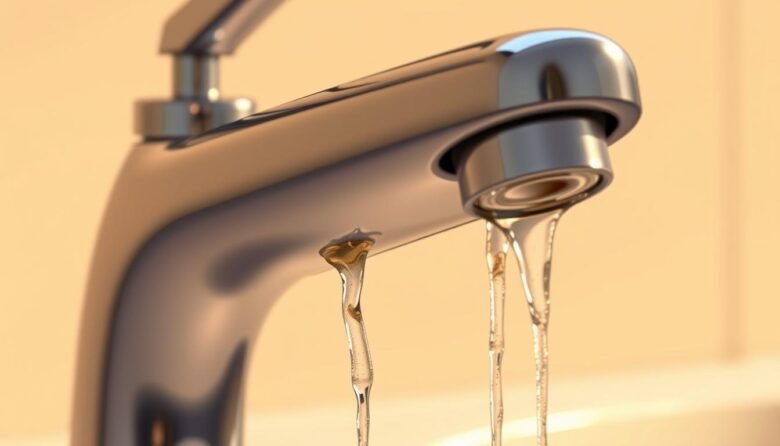Hard water spots can make even the most beautiful fixtures look dull and neglected. These mineral deposits build up over time, creating a cloudy appearance on surfaces.
This comprehensive guide provides professional techniques to instantly remove water stains. You will learn methods to restore your fixtures to their original shine.
We cover both DIY approaches and commercial solutions for different stain levels. Regular maintenance with these techniques prevents long-term damage to finishes.
These methods work on various materials and fit easily into regular routines. With the right approach, you can achieve professionally clean results at home.
Key Takeaways
- Hard water deposits create unsightly spots on bathroom surfaces
- Professional cleaning methods restore original shine instantly
- Both natural and commercial solutions accommodate different preferences
- Regular maintenance prevents damage to fixture finishes
- Techniques work on various materials with slight adjustments
- Step-by-step instructions make the process time-efficient
- Prevention strategies help maintain long-term shine
Understanding Hard Water Stains on Faucets
Many households face the persistent issue of unsightly white marks on their bathroom and kitchen fixtures. These blemishes originate from water with high mineral content flowing through plumbing systems.
What Causes Those Stubborn White Stains?
Water contains dissolved minerals like calcium and magnesium. When droplets evaporate from surfaces, they leave behind solid mineral deposits.
This process creates chalky, white spots that adhere strongly to smooth finishes. The chemical reaction forms calcium carbonate and magnesium compounds that bond with surfaces.
Frequent exposure to water accelerates this mineral buildup. Areas with higher mineral content in their water supply experience more severe staining.
The Long-Term Damage of Ignoring Mineral Deposits
Unaddressed mineral deposits can permanently etch finishes. This corrosion damages protective coatings and exposes underlying materials.
Heavy accumulation may eventually impair fixture functionality. Water flow can become restricted through built-up deposits in aerators and valves.
Certain materials show greater susceptibility to damage from these deposits. Prompt attention prevents permanent deterioration and maintains optimal performance.
The difficulty of removal increases with time as deposits become more ingrained. Regular maintenance preserves both appearance and function of your fixtures.
Essential Tools and Materials for Faucet Cleaning
Having the correct supplies on hand transforms challenging mineral buildup into manageable maintenance. The right combination of natural agents and proper equipment ensures effective results without damaging surfaces.
Natural and Effective DIY Cleaning Agents
White vinegar stands out as an exceptional natural solution for dissolving mineral deposits. Its acidic properties break down calcium and magnesium compounds effectively.
Baking soda serves as a gentle abrasive that lifts residue without harming delicate finishes. When combined with liquid, it forms a paste that scrubs away stubborn buildup.
Lemon juice contains citric acid that naturally dissolves mineral accumulations. This citrus option also leaves behind a fresh scent after application.
Microfiber cloths provide safe scrubbing action for various material types. Soft-bristled brushes work well for textured areas without causing scratches.
Testing any solution on inconspicuous areas first ensures compatibility with specific finishes. Having multiple options available accommodates different stain types and personal preferences.
Safety Gear and Preparations for Cleaning
Protective gloves shield hands from potential irritants in cleaning products. Eye protection offers additional safety when working with splashing liquids.
Proper ventilation becomes particularly important when using concentrated chemical solutions. Opening windows or using exhaust fans maintains healthy air quality during the process.
Organizing supplies before beginning creates an efficient workflow. Keeping natural agents and commercial products separated prevents accidental mixing.
Commercial options include eco-friendly formulations that minimize environmental impact. These ready-made products often combine multiple cleaning agents for enhanced effectiveness.
Preparation includes clearing the work area and protecting surrounding surfaces. This preventive approach avoids accidental damage to countertops or cabinets during the process.
How to Achieve a Lasting Faucet Shine
Effective techniques transform dull fixtures into gleaming centerpieces. These proven methods utilize common household items for remarkable results.
Each approach addresses mineral buildup through different chemical reactions. Proper application ensures thorough removal without surface damage.
The Vinegar Soak Method
White vinegar contains acetic acid that dissolves mineral deposits. This natural solution breaks down calcium and magnesium compounds effectively.
Soak a soft cloth in undiluted white vinegar. Wrap the saturated material around affected areas for 30-60 minutes.
The acidic reaction loosens stubborn buildup during this time. Gently scrub with a non-abrasive sponge after soaking.
Rinse thoroughly with clean water to remove all residue. Dry completely with a microfiber cloth to prevent immediate re-staining.
The Baking Soda Paste Method
Baking soda offers gentle abrasive action for stubborn spots. Its slightly alkaline nature complements acidic cleaners.
Mix equal parts baking soda and water to create a thick paste. Apply this mixture directly to mineral deposits using your fingers or a cloth.
Allow the paste to sit for 10-15 minutes on the surface. The baking soda works to lift and dissolve the buildup.
Gently scrub the area with a soft-bristled brush or sponge. Rinse with clean water and dry immediately for best results.
The Lemon Juice Polish Method
Fresh lemon juice contains natural citric acid that cuts through mineral deposits. This method provides cleaning and freshening benefits simultaneously.
Squeeze lemon juice directly onto affected areas or soak a cloth. Apply the citrus solution to the fixture and let it sit for 10 minutes.
The citric acid breaks down hard water deposits effectively. Light scrubbing with a soft sponge removes loosened residue.
Rinse with clear water and buff with a dry cloth for extra shine. This technique leaves behind a fresh, clean scent.
For particularly stubborn deposits, combine methods sequentially. Start with vinegar soaking, follow with baking soda paste, and finish with lemon polish.
Always test any method on a small hidden area first. This ensures compatibility with your specific fixture finish.
Proper rinsing and drying prevent residue buildup after treatment. These steps maintain your gleaming results longer between cleanings.
The Toothpaste Cleaning Technique for Spotless Fixtures
Many homeowners overlook a common bathroom item that works wonders on mineral buildup. This surprising solution sits in your medicine cabinet and costs very little.
Dental hygiene products contain properties that tackle tough deposits effectively. The same ingredients that polish teeth also work on various household surfaces.
Why Fluoride Toothpaste Works on Mineral Deposits
Toothpaste contains mild abrasives that gently scrub without causing scratches. These polishing agents lift mineral buildup from smooth finishes.
Fluoride compounds react chemically with magnesium found in hard water stains. This reaction breaks down the bond between deposits and surfaces.
Surfactants help dissolve and rinse away the loosened particles. The combination creates an effective cleaning action that removes stubborn spots.
Step-by-Step Application for Optimal Results
Select a fluoride toothpaste like Biotène or Colgate Cavity Protection. These products contain the right balance of active ingredients.
Mix a small amount with water to create a thin paste consistency. Apply this mixture using a soft microfiber cloth.
Allow the paste to work for approximately five minutes. This gives the fluoride time to react with mineral compounds.
Rinse thoroughly with clear water to remove all residue. Buff dry with a clean cloth to reveal the restored finish.
This method works particularly well on chrome, porcelain, and stainless steel. Always test on a small area first to ensure compatibility.
The gentle abrasives polish surfaces while removing unwanted deposits. Regular use maintains fixtures between deeper cleanings.
The Wax Paper Trick for a Protective Shine
Household items often provide surprisingly effective solutions for maintaining beautiful fixtures. This simple method uses common kitchen supplies to create lasting protection against mineral buildup.
Wax paper contains a thin layer of food-grade paraffin wax. When rubbed against smooth surfaces, this coating transfers onto the material.
How Rubbing Wax Paper Prevents Future Water Spots
The transferred wax creates a microscopic barrier on the surface. This hydrophobic layer repels liquid droplets rather than allowing them to cling.
Water beads up and rolls off instead of sitting and evaporating. This prevents mineral deposits from forming new spots after cleaning.
The wax filling also smooths microscopic imperfections in the finish. This creates a more uniform surface that resists adhesion.
Proper application begins with completely clean and dry fixtures. Any existing residue prevents effective wax transfer.
Use firm, circular motions to rub the wax paper across all surfaces. Cover every area that regularly contacts moisture.
Important Considerations for Faucet Finishes
This technique works exceptionally well on chrome-plated fixtures. The smooth, non-porous surface accepts wax coatings beautifully.
Chrome lacks protective coatings that could be compromised by wax buildup. Other materials like brushed nickel or oil-rubbed bronze often have special finishes.
These specialized coatings might interact poorly with wax applications. Always test on a small hidden area before treating the entire fixture.
The protection typically lasts several days with normal use. Reapply weekly for consistent results and maintained appearance.
Combine this method with regular cleaning for comprehensive maintenance. The wax application complements but doesn’t replace proper cleaning routines.
Selecting Commercial Cleaners for Tough Stains
Sometimes household solutions reach their limits against persistent mineral buildup. Commercial formulations offer specialized chemical action for these challenging situations.
These products contain ingredients that target specific types of deposits. Their concentrated formulas work faster than most DIY approaches.
When to Use Professional-Grade Solutions
Heavy calcium accumulation often requires stronger chemical action. White crusty deposits that resist vinegar soaks need professional formulas.
Etched finishes from long-term neglect benefit from specialized treatments. Professional solutions prevent permanent damage to vulnerable surfaces.
Cloudy appearances that don’t respond to natural methods indicate deeper problems. These situations call for manufactured products with enhanced cleaning power.
Eco-Friendly and Effective Commercial Options
Environmentally conscious brands offer powerful yet safe formulations. Seventh Generation and Better Life provide plant-based ingredients that break down minerals.
These products minimize chemical exposure while maintaining effectiveness. They work well on various materials without harsh fumes.
CLR (Calcium, Lime, and Rust Remover) handles severe buildup cases. Its specialized formula targets difficult deposits without damaging most finishes.
Bar Keepers Friend works across multiple surface types safely. This versatile option removes stubborn spots while being gentle on materials.
Always check manufacturer guidelines before application. Different finishes require specific care approaches for optimal results.
Proper ventilation remains important even with eco-friendly products. Follow all safety precautions listed on product labels.
Store these items in their original containers away from children. Keep them in cool, dry locations to maintain product integrity.
Integrate commercial solutions into your maintenance routine as needed. They complement rather than replace regular care practices.
Preventing Hard Water Stains Before They Form
Proactive measures create lasting protection against mineral accumulation. These strategies focus on eliminating the conditions that allow deposits to form.
Effective prevention saves time and effort compared to removal. It also preserves the integrity of your fixture surfaces long-term.
The Importance of Immediate Drying After Use
Quick drying stops mineral deposits before they bond with surfaces. This simple habit prevents the evaporation that leaves behind solid residue.
Use a soft microfiber cloth to wipe fixtures after each use. Focus on areas where droplets typically collect and linger.
This technique works because it removes moisture before minerals can solidify. The method requires minimal time but delivers maximum protection.
Consistent practice becomes part of your routine maintenance. It effectively reduces the frequency of deep cleaning sessions.
Water Softeners and Filtration Systems
Water treatment systems address the root cause of mineral issues. They reduce calcium and magnesium content before water reaches your fixtures.
Whole-house softeners treat all water entering your home. These systems use ion exchange to replace hard minerals with sodium ions.
Point-of-use filters install directly on specific fixtures. They provide targeted protection for frequently used sinks and showers.
Both options significantly decrease spotting and buildup. The choice depends on your water hardness level and budget considerations.
Choosing Stain-Resistant Faucet Finishes
Some materials naturally resist showing mineral accumulation. These finishes maintain their appearance with less maintenance.
Brushed nickel features a textured surface that masks spots effectively. Its matte finish doesn’t show water marks as prominently.
Matte black finishes provide excellent camouflage for mineral deposits. Their dark color makes white spots less visible between cleanings.
Oil-rubbed bronze offers similar benefits with its darker tone. These materials work well in homes with challenging water conditions.
Regular maintenance prevents buildup rather than removing existing accumulation. Combine multiple strategies for comprehensive protection.
Simple lifestyle adjustments minimize mineral formation. These approaches save money compared to repeated removal products.
A complete prevention plan incorporates drying habits, water treatment, and appropriate materials. This combination delivers the best long-term results.
Common Mistakes to Avoid When Cleaning Faucets
Even with good intentions, improper techniques can cause more harm than good to your bathroom and kitchen fixtures. Understanding these common errors helps preserve your investment while maintaining beautiful results.
Using Abrasive Tools That Scratch Surfaces
Many people reach for steel wool or harsh scrub pads when dealing with stubborn mineral buildup. These tools create microscopic scratches that permanently damage protective coatings.
The scratches provide more surface area for future mineral deposits to cling to. This creates a cycle where stains become increasingly difficult to remove over time.
Different materials show damage in various ways. Chrome develops visible scratching while brushed finishes lose their uniform appearance.
Etching occurs when abrasive particles wear away the protective surface layer. This damage cannot be reversed and requires professional refinishing.
Always use soft microfiber cloths and non-abrasive sponges for safe maintenance. These materials effectively remove deposits without compromising finishes.
Applying Harsh Chemicals Incorrectly
Strong chemical solutions require careful handling and proper dilution. Using them at full strength can damage both surfaces and the environment.
Different finishes react differently to various chemical compositions. What works on chrome might destroy an oil-rubbed bronze finish.
Always test any solution on a small, hidden area first. This simple step prevents widespread damage to your fixtures.
Manufacturers provide specific care instructions for their products. Following these guidelines ensures you maintain warranty coverage while protecting your investment.
Over-cleaning can be as damaging as neglect. Excessive chemical exposure breaks down protective coatings over time.
Proper disposal of cleaning products protects waterways and ecosystems. Many communities offer hazardous waste collection programs for these items.
Recognize when professional help becomes necessary. Persistent problems or visible damage often require expert assessment and treatment.
Your Path to Permanently Sparkling Faucets
Maintaining beautiful bathroom and kitchen fixtures requires a comprehensive approach. Consistent care prevents mineral buildup and preserves surface integrity.
Choose methods based on your specific situation and material type. DIY approaches like vinegar soaks and baking soda paste work effectively for routine maintenance.
Specialized techniques address particular needs when required. Commercial products handle stubborn cases that resist home solutions.
Preventive measures provide the best long-term protection. Simple habits like immediate drying make a significant difference.
Develop a schedule that fits your lifestyle and water conditions. With proper techniques, anyone can achieve lasting results.



